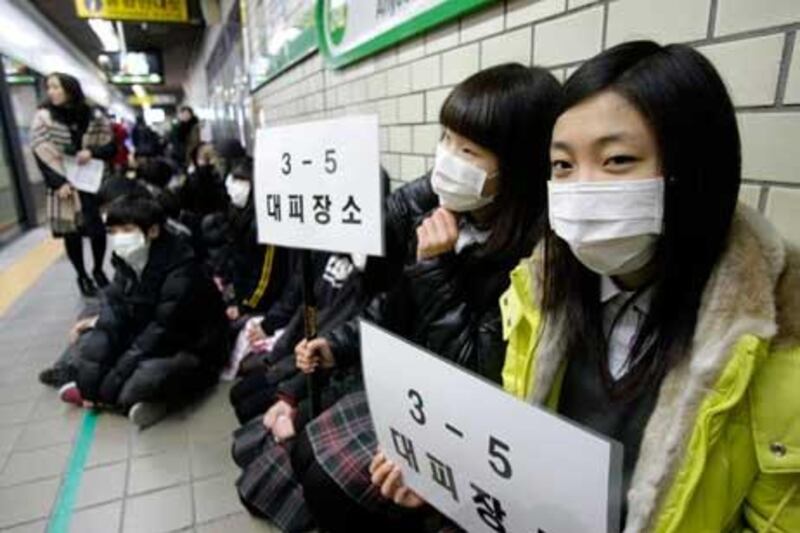BEIJING // South Korea yesterday staged what was billed as its biggest-ever emergency drill, as fighter jets buzzed major cities to simulate an attack from North Korea.
In dramatic scenes in the capital, traffic ground to a halt, people fled to air-raid shelters and put on gas masks, and emergency services personnel donned brightly coloured chemical protection suits.
The drills took place across the country and aimed to involve as many as 12 million people, nearly a quarter of the country's population.
The exercise was held amid a heightened state of alert on the peninsula, less than a month after North Korea shelled an island controlled by its southern neighbour, the first attack on South Korean soil since the end of the Korean war in 1953.
The bombardment of Yeonpyeong island on November 23 killed two young marines and two elderly civilians and turned neighbourhoods into blackened rubble.
In yesterday's drill, which began at 2pm, a dozen "mock North Korean aircraft", reported to be navy jets, flew over Seoul and the south-eastern city of Busan in what the state-affiliated Yonhap news agency described as the largest event of its kind since emergency drills started in 1975.
Pedestrians ducked into subway stations, office basements or dedicated air-raid shelters, with people donning gas masks at a series of underground locations in the capital.
The capital, which lies just 30 miles from the demilitarised zone that separates South Korea from its northern neighbour, has about 4,000 shelters, although most are reinforced subway stations or basements rather than purpose-built refuges. Hundreds of North Korean missiles are said to be capable of striking the capital.
Schools across the country stopped lessons and children fled to underground shelters.
"This is the first time since 2000 that mock enemy aircraft are flown and drivers are asked to park their cars and evacuate to safety during a drill," said Choi Hong-yeong, a spokesman for the National Emergency Management Agency.
It was also the first time for a decade pedestrians had been guided into shelters instead of simply being stopped from crossing roads during a drill.
The drills are typically held on the 15th of each month and, until yesterday, commonly ignored by residents, but the authorities are keen to improve emergency training, with little notice likely if North Korea were to launch an attack.
Shaeb al Neaimi, an Emirati manager who lives in Seoul, was among those travelling by road when the drill started. His friend, who was driving, was told by a policeman to pull over and wait.
"All the cars were stopped by the side of the road," he said. "People here are aware of the dangers of North Korea and they are taking proactive actions so if there's a strike they all know what to do.
"They understand it's something they do. They know how important it is. They obey the law and wait until it's over, then get on with their lives."
Reports indicated many residents did not attempt to enter emergency shelters, and one office worker in the capital said she and her colleagues carried on as normal throughout the drill, despite the government giving yesterday's exercise a much higher profile.
Meanwhile, Bill Richardson, the governor of New Mexico who has visited North Korea on multiple occasions, was yesterday travelling to Pyongyang as the United States, Japan and South Korea continued to resist the resumption of the stalled six-party talks on the North's nuclear programme.
"My objective is to try to get North Korea to calm down a bit, see if we can reduce tension in the Korean peninsula," said Mr Richardson, who added he would report back to the White House following his visit.
Also yesterday, South Korea named Kim Sang-ki as its new army chief in place of Hwang Eui-don, who resigned over a property deal controversy.
Seoul has also replaced its defence minister since the Yeonpyeong incident, with Kim Tae-young being stood down in favour of Kim Kwan-jin, a former chairman of the joint chiefs of staff, following criticism over what was seen as a weak response to last month's shelling.







